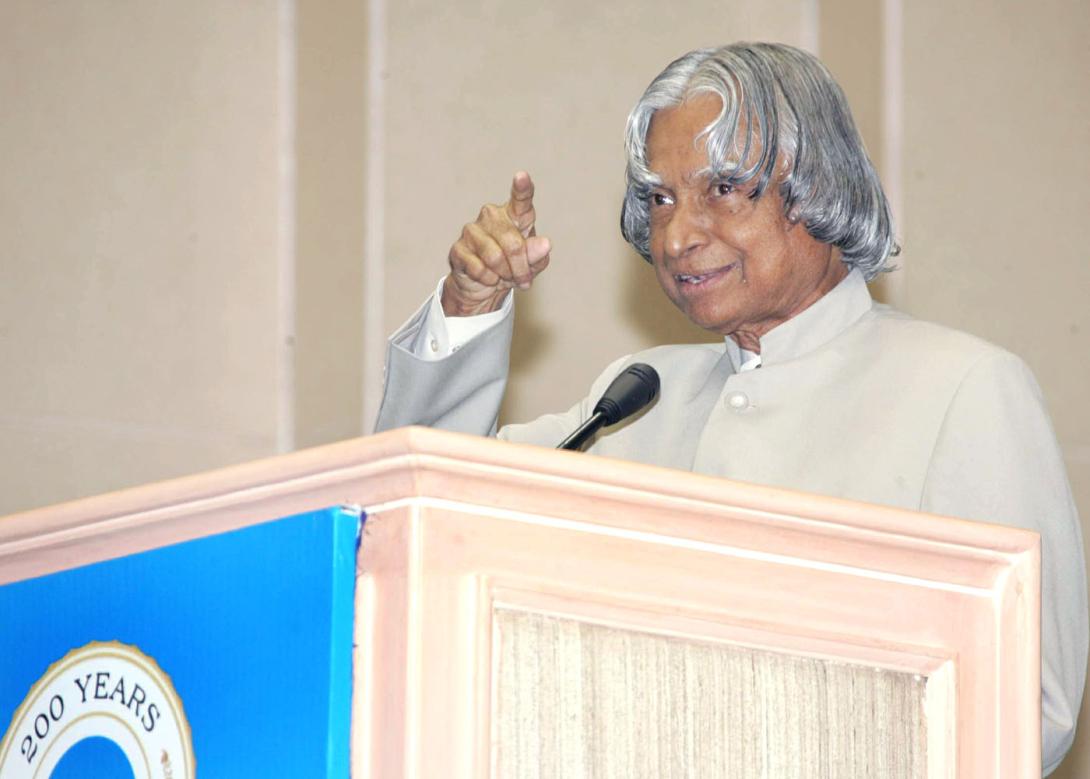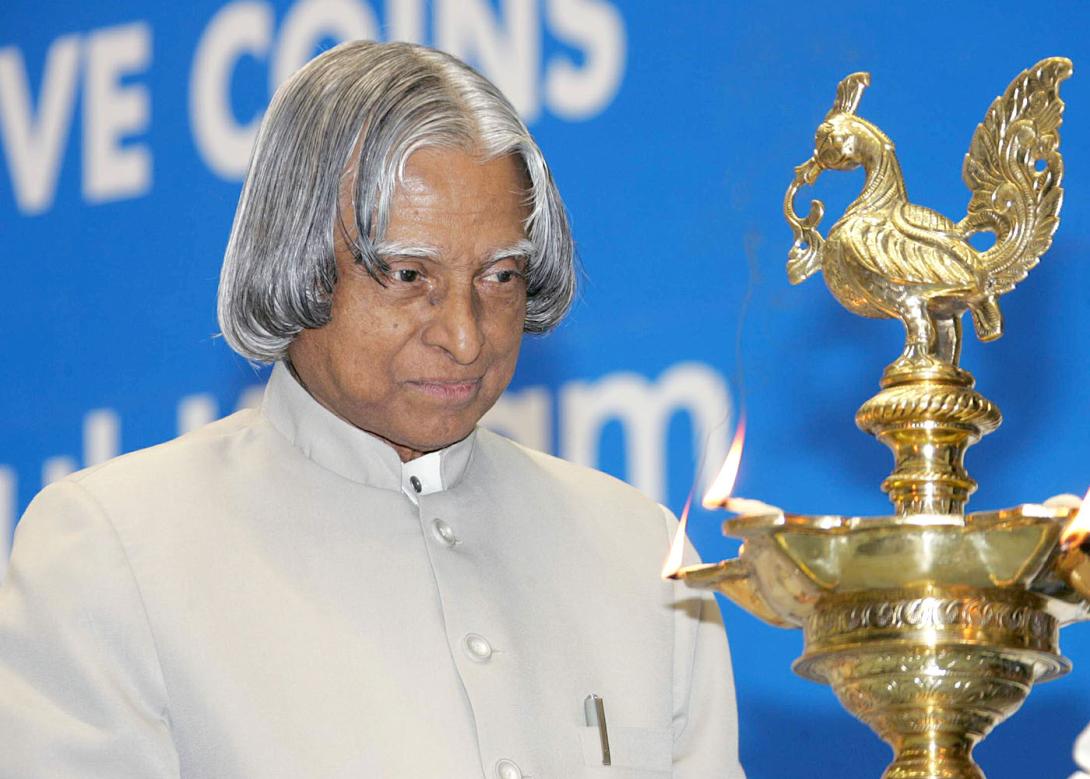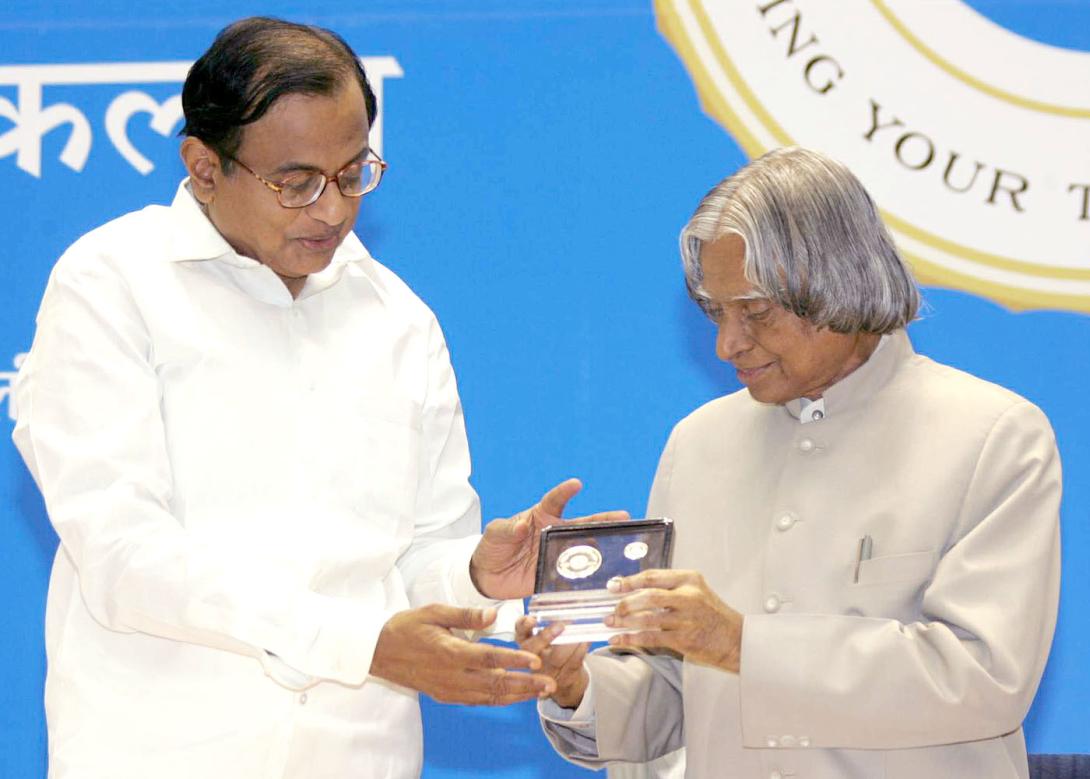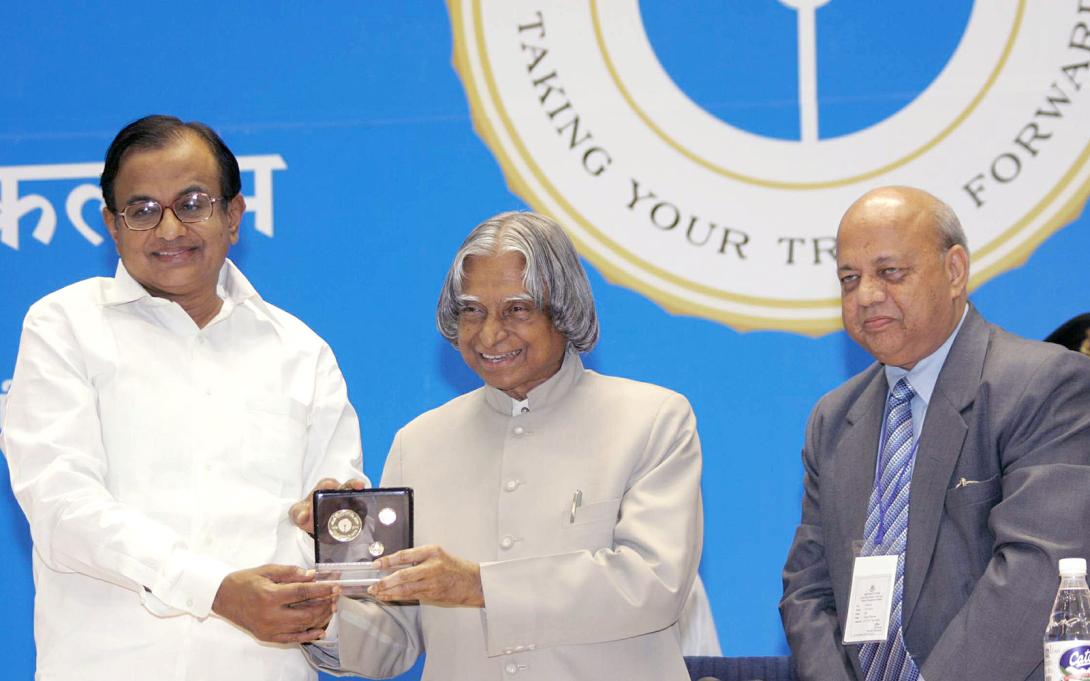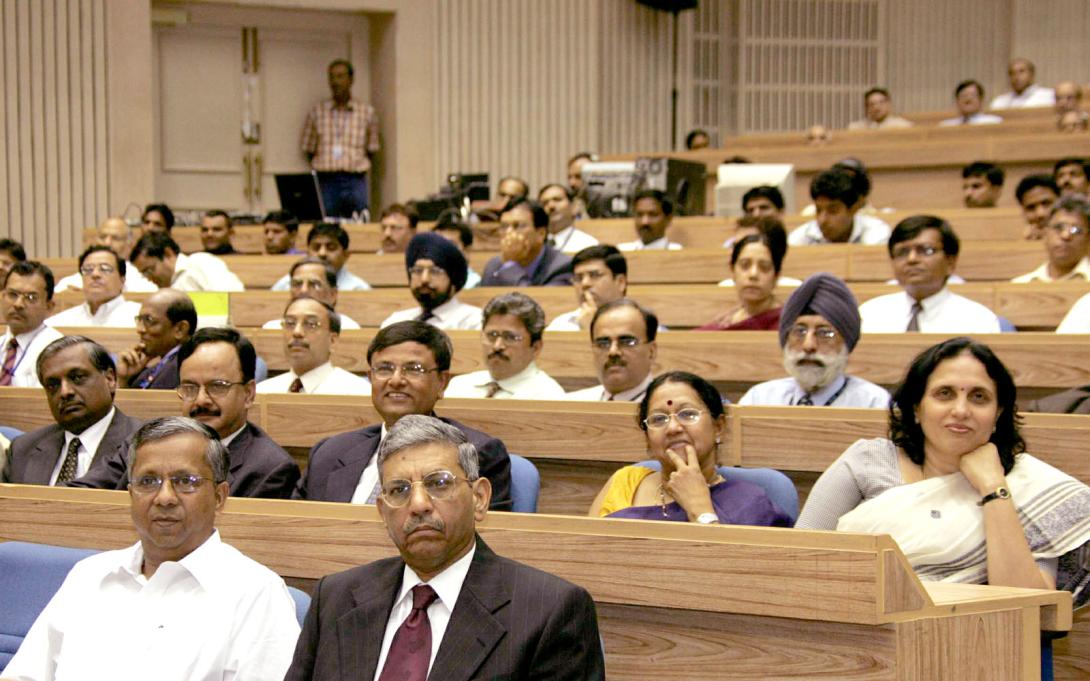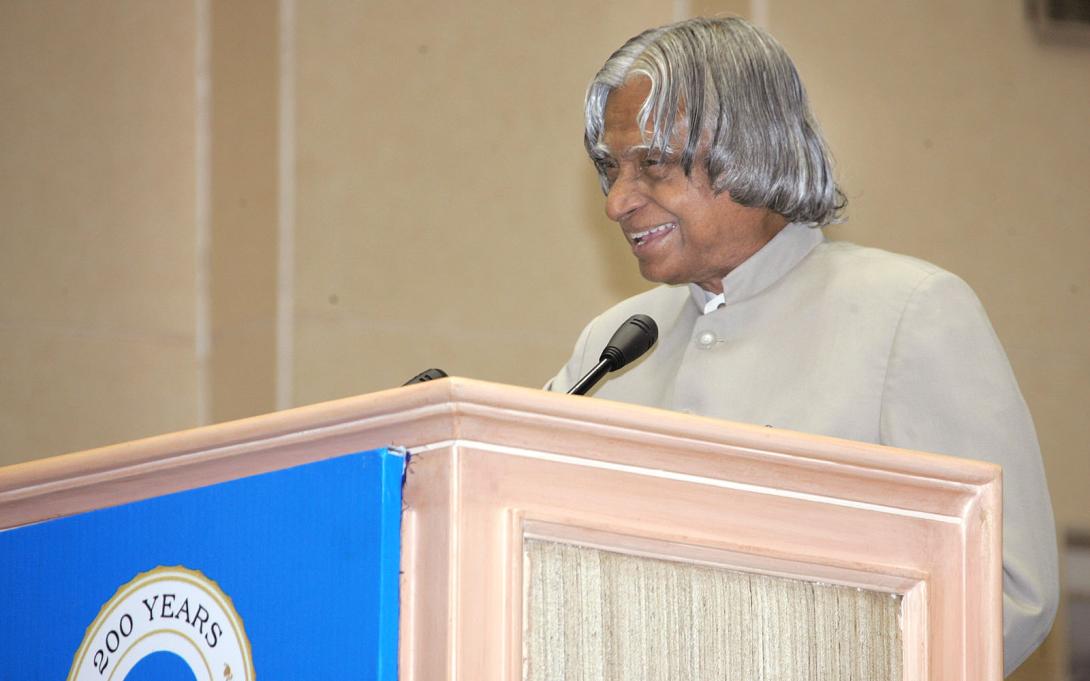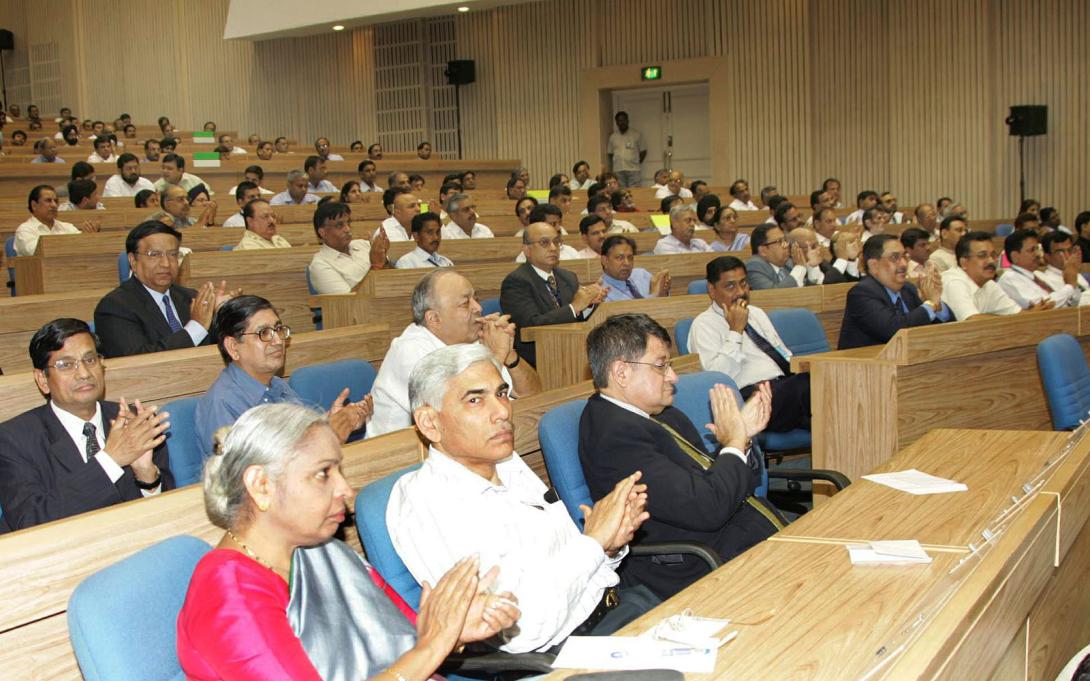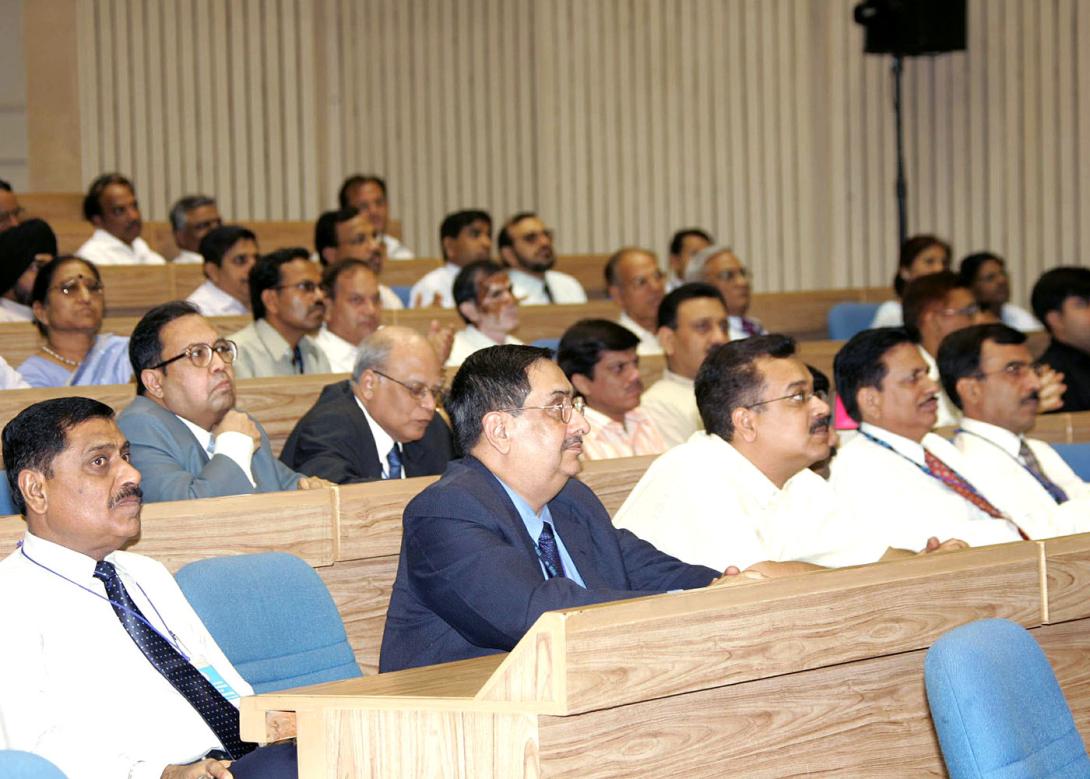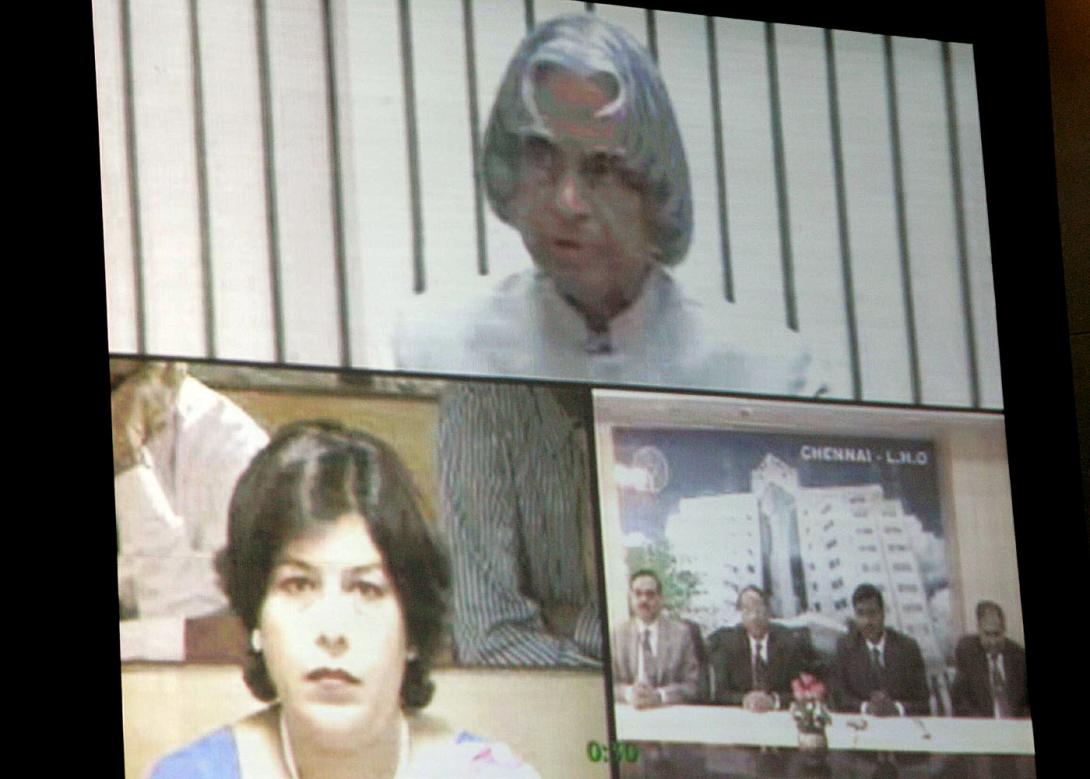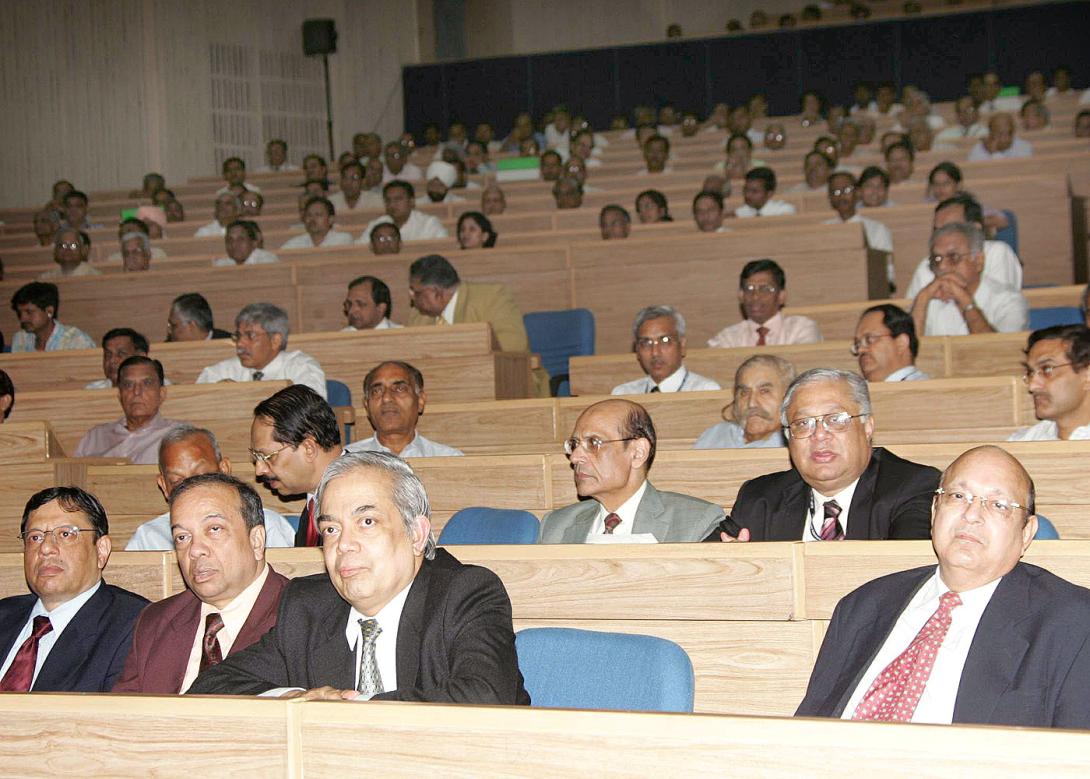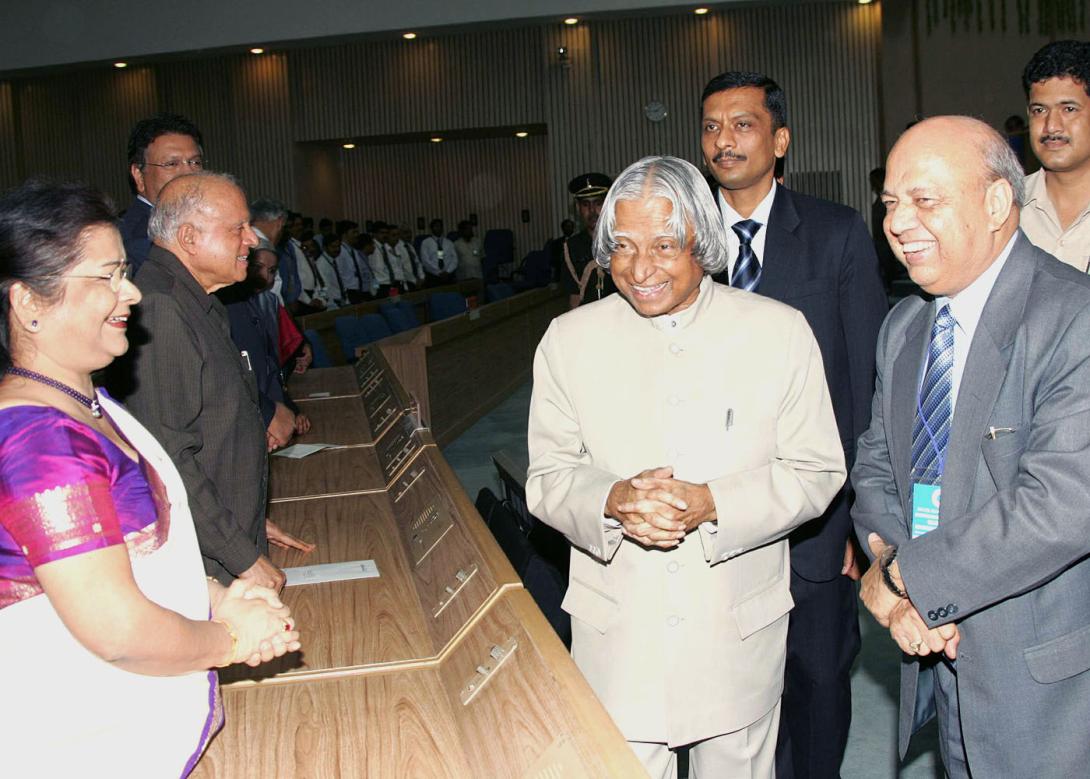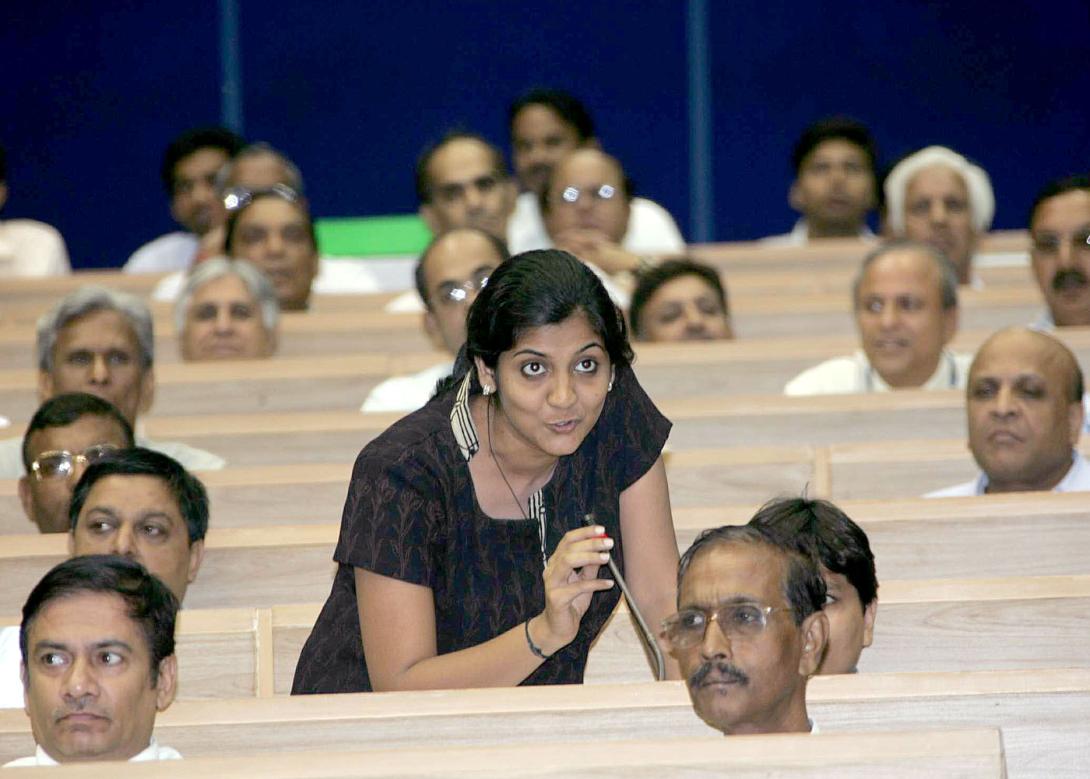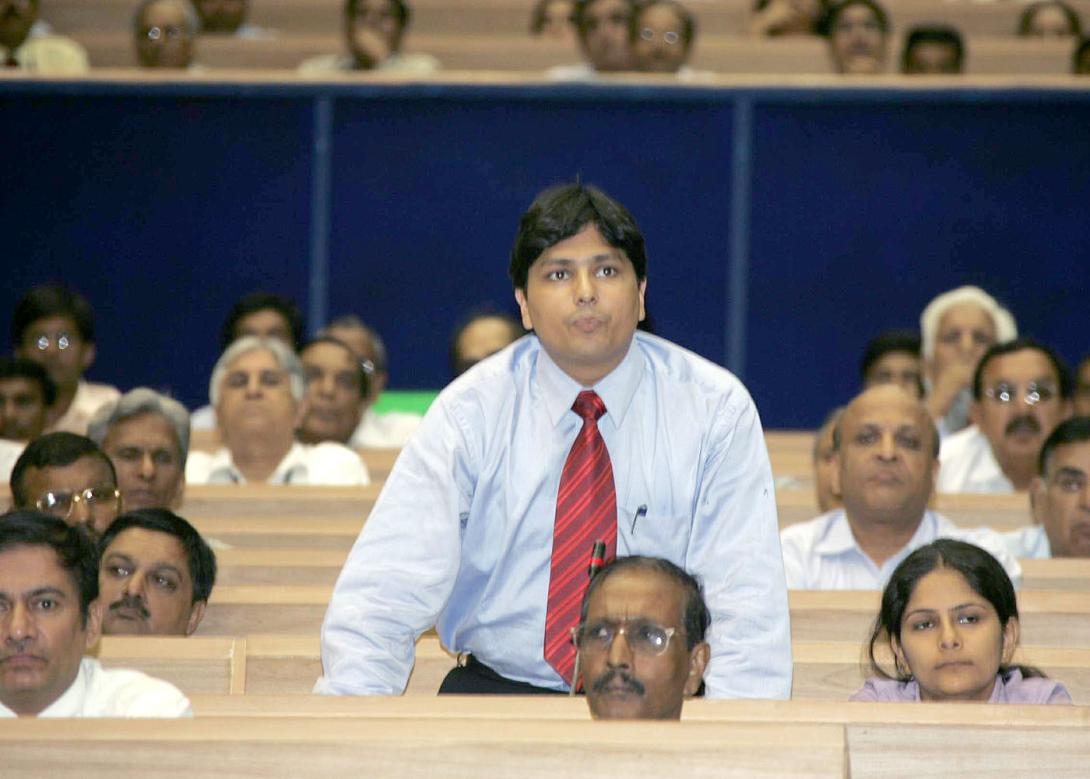Address at the Bicentennial Celebrations of the State Bank of India, New Delhi
Vigyan Bhavan, New Delhi : 30-05-2006
Dynamic Banking and Rural Development Missions
I am delighted to participate in the Bicentennial Celebrations of the State Bank of India. State Bank of India during the last two centuries has been a partner of the Government in every economic activity. The bank has a mission to reach every segment of the society through branch expansion in the remotest corner of the country. The bank has also been successful in cultivating entrepreneurship among the needy through micro finance more specifically through self-help groups. In addition to the computerization of all the branches, SBI has introduced variety of technology enabled services. I am sure very soon you will accept authenticated digital signature for all bank transactions including financial audit. I congratulate the SBI community both present and past who have built a robust institutional framework for Indian banking during the last two centuries. I extend my greetings to the organizers, senior bankers, economists, policy makers, academicians, government functionaries and all the bank employees, particularly young executives, who will carry the bank into the next decade. I have selected the topic for discussion "Dynamic Banking and Rural Development Missions".
Ambience in the Nation
In the Indian history, very rarely our nation has come across a situation, all at a time, an ascending economic trajectory, continuously rising foreign exchange reserve, reduced rate of inflation, global recognition of the technological competence, energy of 540 million youth, umbilical connectivities of 20 million people of Indian origin in various parts of the planet, and the interest shown by many developed countries to invest in our engineers and scientists including setting up of new R&D centers in our country. Above all, India as the largest democracy in the world, has a reputation for its democracy and for providing leadership for the one billion people with multi-cultural, multi-language and multi-religious backgrounds. And also our technological competence and value systems with civilizational heritage are highly respected. Also, foreign investors find investing in India attractive. But we have a long way to go. We have to streamline our procedures and work towards a single window clearance system to attract foreign investment in a big way. Indians are also investing in abroad and open new business ventures. The Government is committed to economic development by ensuring growth rate of 8% to 10% annually and maintaining it for a decade, for enhancing the welfare of the farmers and workers by unleashing the creativity of the entrepreneurs, business persons, scientists, engineers, youth and other productive forces of the society. Let us look at our national development challenges. (i) 40 to 50 million people need productive employment (ii) 260 million people live below poverty line (iii) 600 thousand villages, where our 700 million people live need physical, electronic and knowledge connectivity leading to economic connectivity. To meet the challenges, I will be discussing our national mission and PURA (Providing Urban Amenities in Rural Areas), in conjunction with Bharat Nirman Programme.
When I study the sectoral growth rate of our economy, I find that both manufacturing and services sectors are showing robust growth whereas the agriculture is substantially lagging behind. To raise the agricultural growth to over 4% which is vital for increasing the overall GDP growth to 10% we may have to resort to farm management based approach which will provide the newer technologies to the farming community. Also, we have to invest in agro-food processing so that the farmer gets the benefit for higher yield from his farm through value addition to his produce. A study of the composition of State Bank of India loan book indicates that the loan for agriculture is static at 10%. Hence, there is a need to increase the loan allocation to the agricultural sector along with technological and managerial inputs which will enable us to enhance the growth of this sector over 4% in a time bound manner. Simultaneously, the banks have to become pro-active venture capitalists who can take risks and facilitate development of innovative products suiting to rural needs through creative entrepreneurs. This shift in emphasis is essential for enabling faster growth of Indian economy.
Our National Mission ? Challenges
For transforming India into a developed nation and bring prosperity to all the one billion plus people, we have identified five areas where India has core competencies for integrated action: (1) Agriculture and food processing (2) Education and Healthcare (3) Information and Communication Technology (4) Infrastructure for all parts of the country such as reliable and quality electric power and surface and air transport and (5) Self-reliance in Strategic sectors. These five areas are closely inter-related and when effectively addressed, would lead to food, economic, energy and national security and lead to sustainable prosperity.
The Mission of PURA
One of the important components of national development is the creation of PURAs (Providing Urban Amenities in Rural Areas). PURA envisages integrated connectivities to bring prosperity to rural India. These are - physical connectivity of the village clusters through quality roads and transport; electronic connectivity through tele-communication with high bandwidth fiber optic cables reaching the rural areas from urban cities and through internet kiosks; and knowledge connectivity through education, vocational training for farmers, artisans and craftsmen and entrepreneurship programmes. These three connectives will lead to economic connectivity through starting of enterprises with the help of banks, micro credits and marketing of the products.
Each PURA cluster will connect about 20 villages depending upon the region and population and will cost about Rs.100 crores. After initial short-term employment during construction etc., we have to plan for initiating actions for providing regular employment and self employment opportunities in nationally and internationally competitive enterprises in agro processing, manufacturing and services sectors for about 3,000 people. If the industrial/business parks are marketed well, they can generate employment opportunities in support sector for about 10,000 people for a village complex having 30,000 people. This will provide sustainable economy for the rural sector. The total number of PURAs for the whole country will be around 7,000.
We must realize Bharat Nirman Programme, with an allocation of Rs. 1,74,000 crores for the duration of four years and Rural Employment Guarantee Scheme for 200 districts of the nation ensures availability of adequate funding support for Rural Development Missions.
In this national mission, SBI can promote entrepreneurs in the rural areas particularly in setting up of agro-food processing industries as co-operative institutions based on the core competence of the region. SBI can also support venture capitalists for generating the rural technology needed for the innovative rural enterprises. This will facilitate creation of large scale employment in the rural areas leading to the removal of urban-rural divide. SBI being a leading bank in the country can facilitate development of at least 1000 PURAs. I would like to discuss some of the areas which are good candidates for such rural enterprises.
Bio-products from Seaweed: Coastal PURA Employment Generator
Scientists of Central Salt and Marine Chemicals Research Institute (CSMCRI), Bhavnagar have developed an important thickening agent Carrageenan using seaweed called Kappa-phycus al-vare-zii that bestows useful properties to many commercial products such as toothpaste, ice-cream, pet food and soft capsules. I am happy that SBI is providing loan upto Rs. 5 lakh without collateral security to the women self-help groups in Mandapam region of Tamil Nadu for cultivation seaweed. The scientists have developed a unique technology of liquefying the seaweed without adding any water and thereafter they have separated the solid from the liquid to obtain two products. The solid is the source of car-ra-gee-nan and the liquid has been found to be a very useful plant nutrient rich in potassium and organic growth promoting hormones. This sap has been used in a variety of crops such as sugarcane, paddy, maize, pulses and several fruits and vegetables. The productivity increase has been in the range of 20% to 40% in different regions for different plant varieties as per studies conducted by regional institutions. This highly innovative process of producing two useful products from the fresh harvest of the seaweed is being done for the first time in the world.
I would suggest seaweed cultivation and value addition should be taken up as a mission mode project of fishermen co-operatives and self-help groups of the coastal areas, particularly in the PURA (Providing Urban Amenities in Rural Areas) complexes in partnership with scientists, industrialists and SBI. This will enable creation of industries for producing Car-ra-gee-nan and bio-fertilizer in the coastal PURA itself resulting in substantial amount of revenue increase to the fishermen and farmer.
Jatropha ? Biofuel: Hill & Plain Terrain Employment Generator
Government has decided to permit mixing of 10% bio-fuel with diesel. This has opened up new opportunities for employment and wealth generation. We have nearly 63 million hectares of wasteland available in the country, out of which 33 million hectares of wasteland have been allotted for tree plantation. Certain multi-purpose trees such as Jatropha can grow well in wasteland with very little input. Once grown the crop has a fifty years of life. Many initiatives have been taken for cultivation of Jatropha in different States.
Farmers have started cultivating Jatropha in many areas. But they have certain problems such as low productivity, non-availability of standardized good seeds, technical advice, non-availability of information about oil extraction and esterification equipments and lack of knowledge about prospective purchasers of Jatropha seed or Bio-fuel. To enable the farmers to work without interruption, there is a need to take a comprehensive view of the total chain from Jatropha plantation to efficient extraction, esterification and marketing. While these issues are being taken up, the research and development personnel and entrepreneurs, financial institutions like State Bank of India have to hold the hands of the farmers, researchers and industrialists by way of financing the agricultural process, the research, establishment, operation and maintenance of the industries till the whole process becomes self-sustainable. I understand that SBI has already taken such initiative with the State Governments and the private entrepreneurs. The number of distributed plants established in PURA clusters and the scale of operations has to increase substantially to ensure availability of bio-fuel in the country at least to the extent of 5% of our import of diesel by the year 2010. SBI can initiate action for evolving a promising economic model for bio-fuel production as done by Deutsche Bank for the development, production and marketing of nano technology products which I will be discussing later.
Technological innovations at grassroots
The National Innovation Foundation has been able to scout and spot number of innovations which have taken place in our rural areas.
I would like to share a small innovation that Amrut-bhai of Juna-gad district did when the problem of women, drawing water from the well, was posed to him along with other innovators. While drawing water from 10 ? 15 meters depth women find it difficult to keep holding the rope continuously. Sometimes, the grip gets loosened and the bucket falls into the well. By attaching a small lever over the pulley, Amrut-bhai has solved this problem that helps millions of women. This lever presses against the rope and does not let it slide down. When one has to pull in the rope, it lifts itself without causing any difficulty.
Kanak-das from Muri-gaon, has innovated a new cycle called Kanak cycle. The common people have to use bicycle for commuting locally in the katcha roads. A normal cycle will obviously slow down, given the undulations. In Kanak?s cycle, the energy normally getting dissipated in the shock absorbing springs is transferred with the help of gears to the rear wheel. Kanak has made roads? differential heights work for him. Now the cycle runs faster. It is a platform technology and could be used in various means of transport. There are a large number of such innovators who have developed coconut-husking machine or have developed a hand pump in which 20 per cent water is compulsorily diverted to fill the animal drinking water troughs.
There is a need to encourage these creative minds and convert their inventions into commercial products using technology. R & D institutions, production agencies and SBI must become partners. These products will improve the quality of life of the rural people and become an inspiration for other creative minds apart from providing large scale employment in the rural sector.
Converting the fly ash as Wealth Generator and Clean Environment
As you are aware, the use of coal for power generation results in increased quantum of fly ash production, which has reached about 100 million tonnes per year. All out efforts are needed to utilize this fly ash not only from environmental considerations, but also to avoid land usage for fly ash dumping. Though there has been a steady progress in fly ash utilization from 1990, we have a long way to go to reach the target of 100% fly ash utilization. It is reported that the agricultural increase of grains is around 15%, green vegetables 35% and root vegetables 50%, when fly ash is mixed with the soil. Toxicity tests have proved that there is no toxic element due to fly ash. But it has higher nutrients due to increased availability of iron and calcium. The fly ash can become a wealth generator by making use of it for agriculture and producing "green building" materials. Presently, the fly ash utilization is in the range of 33 million tones per year providing employment for over 50,000 personnel. For full utilization of the generating stock, will provide employment potential for three hundred thousand people and result in a business volume of over Rs. 4000 crore per year. SBI can facilitate creation of small enterprises for producing green building materials using fly ash in the rural sector in partnership with village co-operatives and small enterprises.
Electricity Generation through Municipal Waste
Increased urbanization has led to a serious problem of accumulation of municipal solid waste. Efficient and environmentally clean disposal of garbage has always been a major technological challenge. While being a threat to the environment, mounting garbage is also a rich source of energy. The potential for converting this waste into useable energy, which will eliminate a major source of urban pollution, was realized by one of our innovative organizations - Technology Information Forecasting and Assessment Council of Department of Science and Technology which helped in developing a completely indigenous solution for the processing of waste into a source of fuel. This fuel could, in turn, be used for generation of electricity through mini plants. Two entrepreneurs in Andhra Pradesh adopted the technology with refinement and established two independent plants in Hyderabad and Vijayawada generating over 12 megawatts of electricity which is being supplied to the State Grid. India needs thousands of mini power plants using municipal waste in small towns and urban areas. Banking sector can provide the thrust for promoting creation of such power plants in major municipalities with the collaboration of small and medium enterprises. Recently, I have come across a "plasma enhanced melter system". In this system high temperature, DC plasma arc is used to gasify the waste in a steam reforming atmosphere to convert organic material into a synthesis gas - a mixture of mostly hydrogen and carbon monoxide. This gas is used to fuel in an internal combustion engine for generating electricity. SBI may consider assessment of this technology for cost effective utilization by our municipalities.
Presently, the development finance responsibility with its inherent risks is squarely and fully on the banking sector and particularly on State Bank of India. It is in this background, I wish the SBI community to play a positive role to assist the country to march towards faster development through application of science and technology and continuous innovation.
No reward without risk
I have given many typical economic activities and employment generating methods for our nation. At the same time, I realize that banks are always assessed in three important dimensions of performance.
a. Fast recovery of the loan
b. Enhancement of economic performance of the bank itself.
c. Maintaining the competitive edge of the bank.
In the three dimensional sequence, banks are required to follow systematic procedure before they support an economic activity or sanctioning a venture capital. Of course, it is known that in banking business very rarely success comes to people who do not take certain calculated risk. Now, I would like to talk about the bankers'role in emerging areas of science and technology.
Bankers leading the development
In April 2004, a national meet on Nano-technology and its application, was organized at Rashtrapati Bhavan. The present world market for nano materials, nano tools, nano devices and nano biotechnology put together is over hundred billion dollars. It has been noticed that the fastest growing area among these is nano-biotechnology. Health sector and industrial applications are priority areas for India. In this connection, I happened to study the Nano-technology Market and Company Report "Finding Hidden Pearls" supported by Deutsche Bank. This economic study report costs Rs. 1.4 lakhs. The study provides the over view for the industrialists and the entrepreneurs to venture into the developing economy in a right path. It gives the following:
(a) an up-to-date report on nano-technology companies and products that are already in the nano-technology market or will appear in the market soon.
(b) identifies the key challenges and the time frame for future nano-technology products through expert interviews.
(c) provides realistic market figures based on existing nano-technology products for various applications.
This report provides valuable inputs to venture capitalists, financial and economic analysts, consultants, marketing managers, R & D managers, researchers and vendors involved in nano-technology products. What I would like to emphasize here is that the initiative for the preparation of the report has emerged from the banking community. This shows how the banking community can be forward looking with the association of technical personnel and can facilitate the policy makers, scientists, researchers, industrialists and entrepreneurs to undertake different jobs connected with nano-technology products and services. It is estimated that the nano-technology market is likely to reach $ 1-2 trillion dollars by 2015. I would suggest that State Bank of India may undertake such forward looking projects relevant to Indian environment in order to meet the international demand and come out with comprehensive reports and business proposals which will provide different segments of society a clear direction for channelising their effort and investment leading to national prosperity. This indeed is a proactive action of the bankers.
Education Loan for our Youth
I was very happy to see the advertisement of State Bank of India about the provision of scholar loans without security, collateral, third party guarantee or co-borrower at low interest rates payable in seven years. However, I was slightly disappointed to note that this facility is available only for students in best engineering colleges, medical colleges and top business schools. I would request the SBI to examine the possibility of providing loans to students who would like to pursue science and commerce as a career. In addition, they must also find a method to make the loan facility available to meritorious students who could not get admission into top engineering, medical or B-school in view of stringent competition. This is required for providing equitable opportunity for our youth to pursue higher education, develop skills which is vital for participation in the national development process. It will also enable creation of the global human resource cadre in the nation which envisages 50% of the Indian youth to acquire higher education in university and the other 50% to acquire world class skills needed in all the sectors of the economy. I would suggest the banking system, education system and the industries should work together and create an environment and build capacity among our youth to become job creators rather than job seekers. This will ensure positive repayment of the loans drawn by the youth. This creation of the human capital will be the greatest contribution made by SBI for national development particularly when India is blessed with five hundred and forty million youth below twenty five years of age.
Adoption of Schools
I understand that there are around 14,000 SBI branches spread all the country. I would recommend at least 10% of these branches namely 1,400 to adopt at least one primary and one secondary school each in their respective region of operation for improving the infrastructure and promoting value based quality education to the youth in that region. This mission will enhance SBI business.
Proactive banking
With the branches spread over the whole country and the continuous requirements for on the job training, banks can use modern technology of tele-education. The seamless world, global outlook, competition and expectation of customer have increased the responsibility of banks to seek ways for ensuring total customer satisfaction through constant innovation promptness and customer friendly attitude of the bank employees, motivation for entrepreneurs, simplification of procedures, calculated risk taking and feedback system. The banking system has to anticipate the needs and challenges of 21st century banking and prepare itself rather than react to them.
While technology, particularly, the Information and Communication Technology (ICT) has greatly influenced the working of banks, there is a need for consistent training of bank employees for deriving the best from technology in the competitive environment. Technology is a double edged weapon. While it provides easy access to consolidated financial and private information, there is a need to deny the accessibility of information to unauthorized agencies through state-of-the-art security system.
Missions for State Bank of India
I would suggest the following seven missions for the consideration of SBI for immediate implementation:
a. Increasing the agriculture and agro processing credit to 20% of the total loan disbursal within the next three years with visible productivity faster. This will include advances for setting up of PURA complexes and small enterprises in PURA clusters.
b. Creating and nurturing five rural development projects similar to bio-fuel project and sea weed project which can be applicable for large number of villages leading to employment generation through enterprises for at least five million rural youth.
c. Adopting and innovatively funding at least one lakh sick SSI units so that latest technology can be infused and they can overcome the present problems and become profitable ventures within the next three years.
d. Providing funds at competitive interest rates for creation of corporate hospitals which can provide networked healthcare for the rural community through medical insurance on Yeshaswini model followed by Karnataka and also attract medical tourists for cost effective treatment through our quality doctors.
e. Participate in infrastructural development including provision of 50 million energy and water efficient quality houses with basic infrastructure in the rural areas in association with state and central urban development authorities.
f. Allocating at least Rs. 5,000 crore for SBI Cap Venture for funding to innovative scientists and technologists who can provide quality ideas for faster societal transformation commencing from the financial year 2007-08 including development of ICT based knowledge products, software development and provision of software services. When I studied the performance of ICICI Venture, I found one of the beneficiaries ?Pantaloon Retail? has increased its profitability almost 20 times in less than seven years generating 13,000 direct jobs and one lakh indirect jobs. We need a large number of such venture capital institutions.
g. Dynamics of Villagers loan: I have seen myself, how villagers barrow money from "B" to payback the loan taken from "A". Next stage they borrow money at a higher interest rate from "C" to pay back "A" and "B". Such burden of cycle of loan creates many societal problems. Recently in one of the states, people with money have gone to each house and given loans at high interest rates, after deducting the interest. You are experts and you have a social responsibility. I would like you to introduce a villager friendly banking system which will free the villagers from such cycles of loans.
Concluding Remarks
When I am with you, I am reminded of famous statement of Maha Rishi Patanjali in Yoga Suthra -"When you are inspired by some great purpose, some extraordinary project, all your thoughts break their bounds: Your mind transcends limitations, your consciousness expands in every direction, and you find yourself in a new, great, and wonderful world. Dormant forces, faculties, and talents become alive, and you discover yourself to be a greater person by far than you ever dreamed yourself to be".
That was a saintly saying to all of us. Friends, a nation is made great by the thoughts of its people and their actions. The people in turn become important citizens of that great country. The next 15 years period, I consider, is a period of technology transformation in India. I anticipate new emerging economic situations. India is marching towards becoming a knowledge society with focussed tool of information technology and entrepreneurial push partnered by banks. All of you assembled here have an important role to play in the development process through creative leadership. Who is that creative leader? What are the qualities of a creative leader? The creative leadership is exercising the task to change the traditional role from commander to coach, manager to mentor, from director to delegator and from one who demands respect to one who facilitates self-respect. Such leaders of the bank will facilitate the SBI to become the top ranking bank of the country from the existing rank of 29 as reported in Business Today. The higher the proportion of creative leaders in the banking sector, the higher the potential of success of vision of developed India.
I congratulate all the members of the SBI community during the Bicentennial Celebration. My best wishes to the SBI for success in their mission of becoming the best development banker in the world.
May God bless you.
Question and Answer Session
1. India is rich in natural and human resources. Is the enormity in size and diversity our primary handicap? Or we just need a capable top management at the helm of affairs?
- Ms Deepa Vasan, Corporate Accounts Group
Ans: Enormity of size and diversity has to be taken as an advantage. If the size can be broken down in diverse areas individual sizes will become smaller and focused attention can be paid to that area. For example, in the coastal area sea weed cultivation should find emphasis along with fishing to supplement the income of fishermen. In the plain areas, apart from food grains farmers can concentrate on bio-fuel plantation. Once the entire country is broken down into seven thousand PURAs having economic activity using the core-competence of that region, there will be uniform prosperity for the whole nation. This will ensure full utilization of the natural resource using the globally competitive human resource. What is needed is the spirit that "we can do it".
2. What measures do we plan to increase awareness among the people of India in terms of their essential rights, educational opportunities, taking technology to the poor, developments in agriculture, investment plants for their small saving etc.
- Mehek Marwaha, International Banking Group
Ans: Recently, I was attending the inauguration of the Students Legal Literacy Club in Bangalore. The members of this Club are planning to disseminate the essential legal knowledge among the rural people in their region. Such legal clubs are required all through the country to educate the people about their rights and responsibilities. In Bihar and Gujarat there are mobile legal aid clinics providing help to the rural people. Village knowledge centres have been established in rural areas. These village knowledge centres are going to be serviced by the fellows of National Virtual Academy who provide domain knowledge to the rural community in different areas. In addition, Kisan Call Centre has been provided by the agricultural ministry which provides knowledge base to the farmers and fishermen on all issues pertaining to farming through a toll free number.
3. With the economy opening up and political compulsion driving the internal economic environment how does the Government propose to balance the growing commercial aspirations and social obligations of the public sector enterprises in India?
-Shri Amith Bansal, PB Business Unit
Ans: A new class of managers has to emerge who provide a balance between profit and value systems. This type of managers will be able to fulfil the social obligations of the public sector enterprises through their ethical practices and righteous conduct in all their deals. Success of corporate in the coming decade will depend on leadership quality which lay emphasis on performance and transparent value system.
4. With 540 million population under twenty five years of age how do you propose to utilize this resource for building a great nation? How do you propose to train them? What are the prime areas of focus for your Government?
- Shri Prateek Dwivedi, PB Business Unit
Ans: Please don?t say your Government. Since you have elected you should say our Government. In the 21st century, world needs large number of talented youth with higher education for the task of knowledge acquisition, knowledge imparting, knowledge creation and knowledge sharing. At present India has five hundred and forty million youth under the age of 25 which will continuously be growing till the year 2050. Keeping this resource in mind, the Universities and educational systems in India have to create two cadres of personnel: (1) Youth with expertise on special skills (2) Youth with higher education with research and technology expertise. These two cadres will be required not only for powering the manufacturing and services sector of India but also will be needed for fulfilling the human resource requirements of various countries. It is essential to increase the through put of the higher education system from the existing 6% to 20% by the year 2015, 30% by the year 2020 and 50% by the year 2040. Others who are not covered by the higher education system will have world class skill sets in areas such as construction, carpentry, electrical systems, repair of mechanical systems, fashion design, para-legal, para-medical, accountancy, sales and marketing, software and hardware maintenance and service, software quality assurance personals etc. All youth are required to have a world class higher education or world class skills sets.
5. Indian society is witnessing a major change in terms of life style and also through patterns. But still in this transforming society we constantly hear cases of female foeticide, dowry death and domestic violence. Government has made efforts towards this cause. But it has not been largely effective and we still hear stories of violence against women from all strata of society. How does the Government plan to start, support and strength the women empowerment?
- Shri Megha Srivastava, International Banking Group
Ans: I would suggest that the societal transformation and religious organization can create a movement by which the tendency among our population to resort to female foeticide is reversed. It will involve talking to the doctors, nurses, para-medical staff and mid-wives. They should be educated about the long term effect of this practice on the society and they should also be told that the technology must be used for the good of the humanity. It should grow the humanity instead of destroying it. One of the prime reasons for families to prefer a male child is the large scale prevalence of dowry. It is essential to educate the families to put an end to this practice. The third area could be the education imparted to the youth. The youth both boys and girls should be made aware of the long term consequences of this social discrimination. Once, they are convinced about its adverse consequences they should become the champions of this cause to put an end to female child foeticide. Schools and colleges during the moral science class can propagate the doctrine "No human has the right to destroy any life". I am reminded of a divine hymn
Righteousness
Where there is righteousness in the heart
There is beauty in the character.
When there is beauty in the character,
there is harmony in the home.
When there is harmony in the home.
There is an order in the nation.
When there is order in the nation,
There is peace in the world.
6. Our country has a President who is from a scientific background. Scientific and engineering development has been considerable over the years. But, however the fruit of this successes have not been able to reach the masses. Can the Government come up with a policy to see that the masses are benefited from this?
- Shri S. Ashok Varadhan, SME Business Unit
Ans: Tele-density in the country has gone up to 11% from 1%. Today, we have an exclusive EDUSAT satellite for education which can connect all the remote areas in the country and provide quality education to the children. Broadband has reached upto the block level in all the Districts. Wi-max is providing last mile connectivity now. The country is able to provide cost effective Pharma products to our people. The CARTOSAT - the earth mapper apart from providing resource data is an asset for disaster management. Television and radios is available in every part of the country. Science and Technology has helped the farmer to increase the productivity. India has become the largest producer of milk and dairy products. Electricity is almost reaching to all the villages. Recently, I have visited a village which is electrified through solar energy. Our healthcare system is constantly improving. Thus we can see considerable growth has taken place in science and technology reaching the common man. However, much more needs to be done to enhance its impact on the people and we all have to work together to realize this goal. PURA and Bharat Nirman Programme are designed to enable the flow of science and technology to the masses.
7. There is a need to increase the infrastructure to have more research and development in the field of pure sciences. Hence, why is there no expansion in the field to stop brain drain and increase our standing in pure sciences and research?
- Ms. Vandana Krishnia, PB Business Unit
Ans: The Government of India has decided to create a two new institutions devoted to science education and research to be named ?Indian Institutes of Science Education and Research.? The Institutes would be located at Kolkata and Pune and will integrate under-graduate education, post-graduate education and research under the same umbrella. This is an important infrastructure for research in pure sciences. In my view, there is a need for creation of a organized scientific cadre with assured career growth for enabling the parents to permit their children to take up this cadre. Department of Space, Department of Defence Research, Department of Atomic Energy, Universities and other science department of Government of India should take scientists coming from this cadre for their research programme. This will definitely enable enhancement of scientific standing of the country. As far as brain drain is concerned, when over four hundred thousand scientists and engineers are qualifying every year, if small percentage seek employment in other countries we should not be worried about it. While working abroad, they maintain the umbilical connectivity between the family and the institution where they studied.
8. The financial services sector in corporate India is booming as is our economy. With the high degree of professionalism and specialization involved many young graduates are turning towards this sector and availing opportunities. Sir, it won?t be wrong to say that the manthra for the day and the time to come is specialization and the age-old maxim of generalization has to depart. How do you see specialization taking root in the financial services sector? What is your vision for and advise to young professionals in corporate India?
- Shir Amit Pradhan, Mid-Corp Group
Ans: For young professional, I would suggest that they must excel in any area of specialization they undertake. They should specialize as bankers for rural development. They should be able to spot the inherent strength and core competence of the villages and provide necessary financial support for making the village economy self-sustaining. Rural management has to become a specialized subject. Young executive may like to carry out research on PURA.

